Analysis of Optus's Cash Flow, Income, and Tax Accounting Practices
VerifiedAdded on 2021/05/31
|13
|3093
|21
Report
AI Summary
This report provides a comprehensive analysis of Optus's financial statements, focusing on cash flow, other comprehensive income, and corporate income tax. The analysis begins with an examination of the cash flow statement, highlighting changes in operating, investing, and financing activities over a three-year period. It then delves into the components of other comprehensive income, including cash flow hedges and the impact of exchange rate changes. Finally, the report explores Optus's accounting for corporate income, including current and deferred income tax expenses, deferred tax assets and liabilities, and the differences between tax payable and tax expense. The report emphasizes the importance of these financial elements in understanding Optus's overall financial performance and strategic decisions. The report highlights the impact of changes in financial activities such as income tax paid, dividends, investments, and loans, and the effect of deferred tax assets and liabilities.
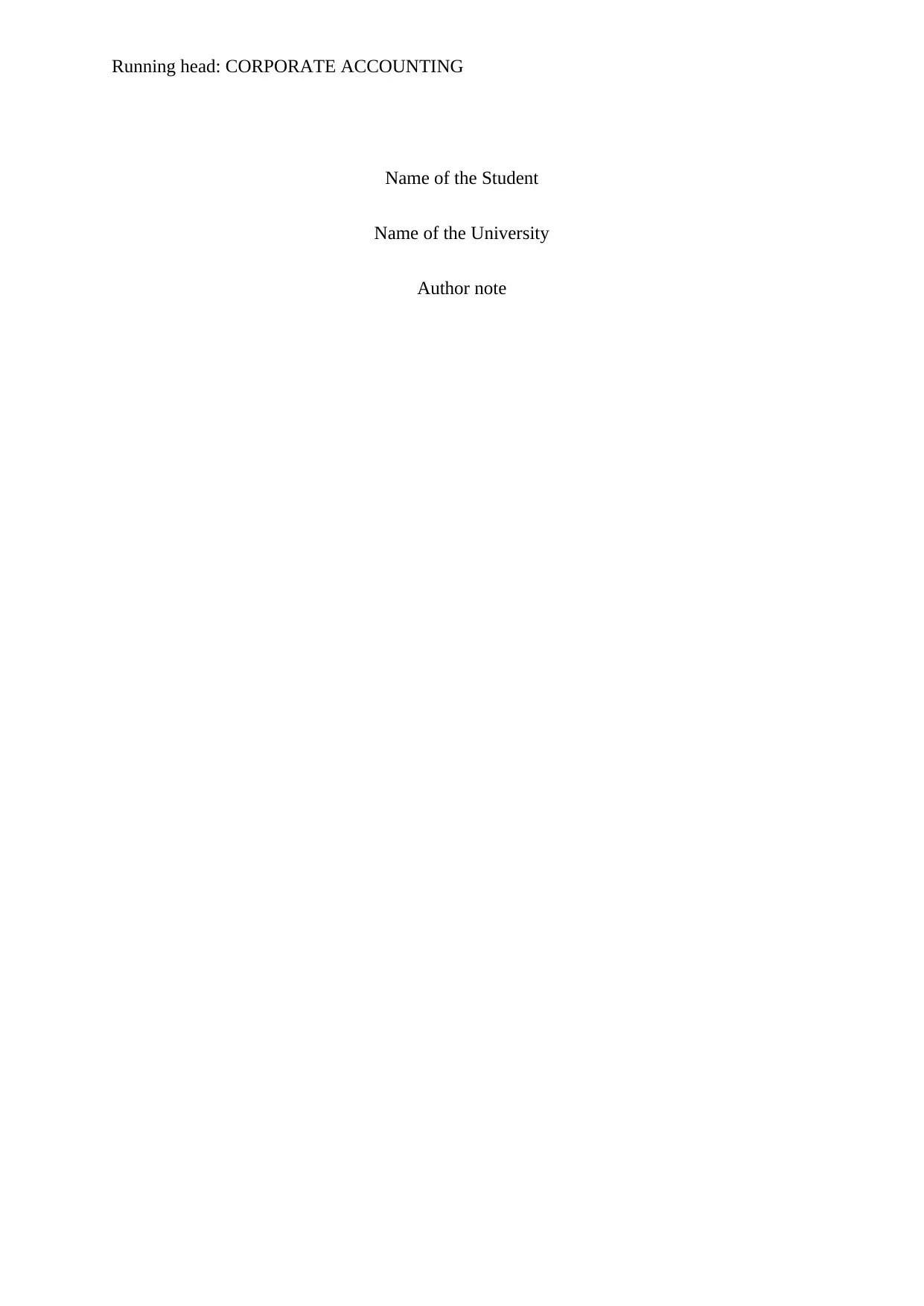
Running head: CORPORATE ACCOUNTING
Name of the Student
Name of the University
Author note
Name of the Student
Name of the University
Author note
Paraphrase This Document
Need a fresh take? Get an instant paraphrase of this document with our AI Paraphraser
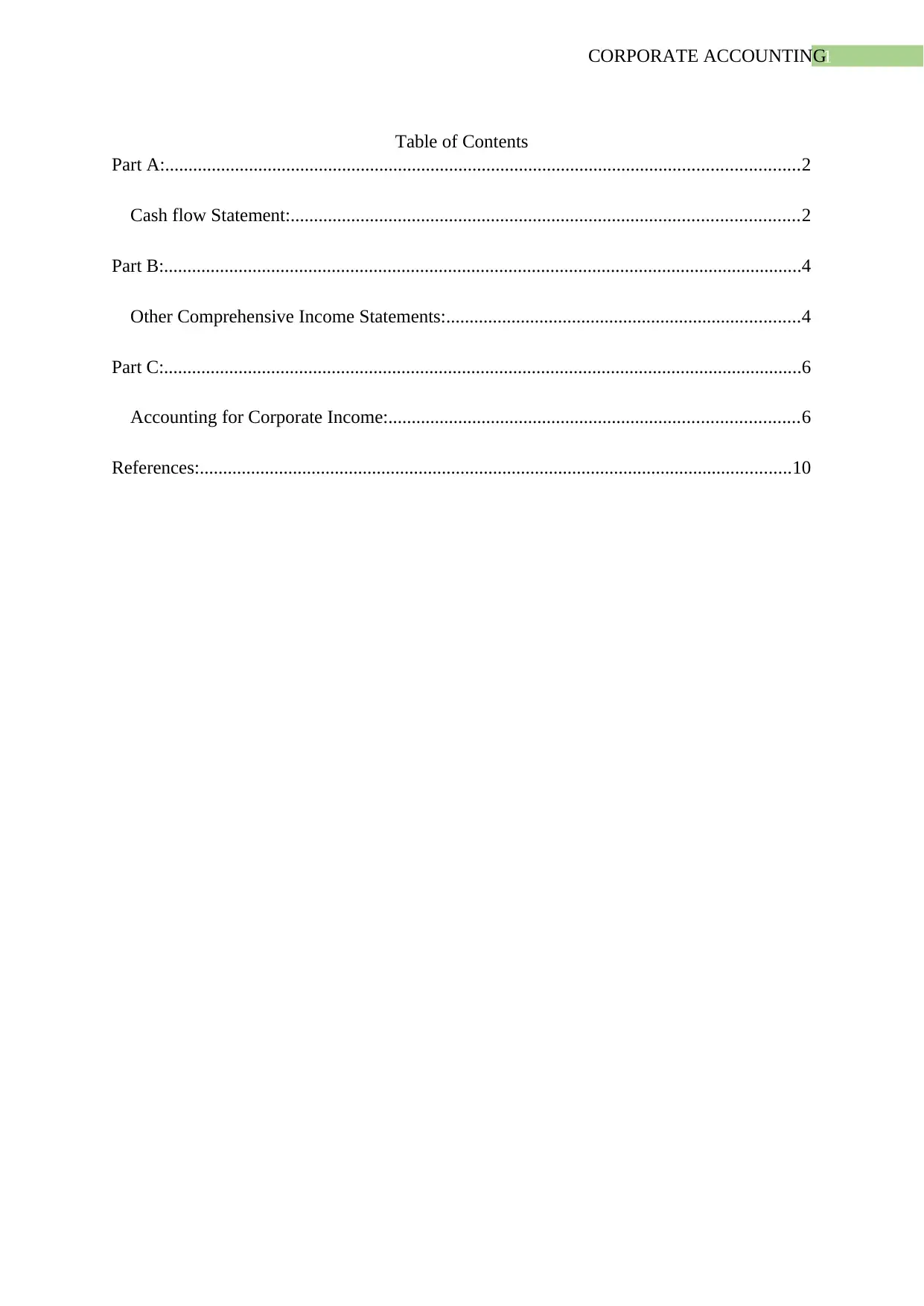
1CORPORATE ACCOUNTING
Table of Contents
Part A:........................................................................................................................................2
Cash flow Statement:.............................................................................................................2
Part B:.........................................................................................................................................4
Other Comprehensive Income Statements:............................................................................4
Part C:.........................................................................................................................................6
Accounting for Corporate Income:........................................................................................6
References:...............................................................................................................................10
Table of Contents
Part A:........................................................................................................................................2
Cash flow Statement:.............................................................................................................2
Part B:.........................................................................................................................................4
Other Comprehensive Income Statements:............................................................................4
Part C:.........................................................................................................................................6
Accounting for Corporate Income:........................................................................................6
References:...............................................................................................................................10
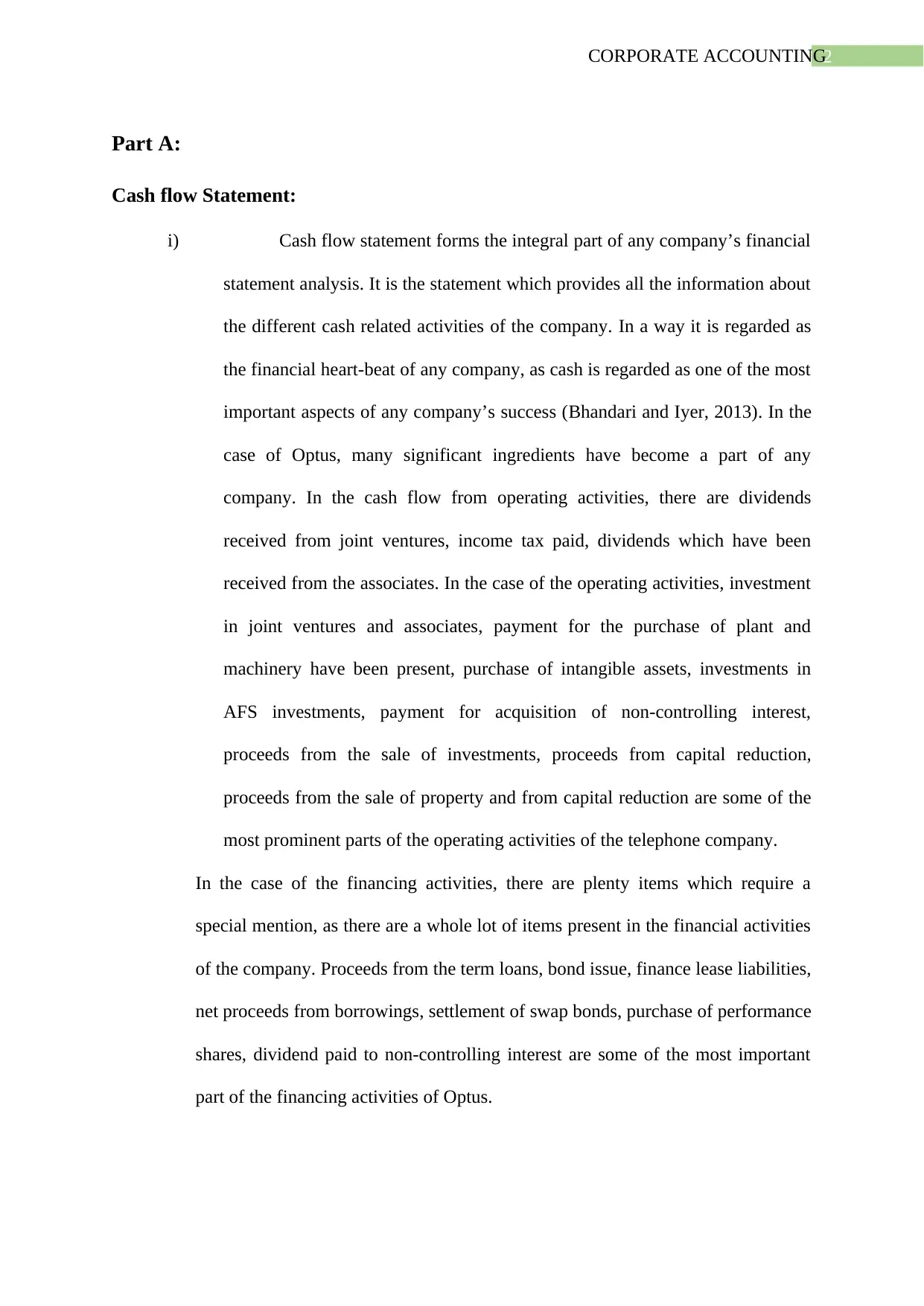
2CORPORATE ACCOUNTING
Part A:
Cash flow Statement:
i) Cash flow statement forms the integral part of any company’s financial
statement analysis. It is the statement which provides all the information about
the different cash related activities of the company. In a way it is regarded as
the financial heart-beat of any company, as cash is regarded as one of the most
important aspects of any company’s success (Bhandari and Iyer, 2013). In the
case of Optus, many significant ingredients have become a part of any
company. In the cash flow from operating activities, there are dividends
received from joint ventures, income tax paid, dividends which have been
received from the associates. In the case of the operating activities, investment
in joint ventures and associates, payment for the purchase of plant and
machinery have been present, purchase of intangible assets, investments in
AFS investments, payment for acquisition of non-controlling interest,
proceeds from the sale of investments, proceeds from capital reduction,
proceeds from the sale of property and from capital reduction are some of the
most prominent parts of the operating activities of the telephone company.
In the case of the financing activities, there are plenty items which require a
special mention, as there are a whole lot of items present in the financial activities
of the company. Proceeds from the term loans, bond issue, finance lease liabilities,
net proceeds from borrowings, settlement of swap bonds, purchase of performance
shares, dividend paid to non-controlling interest are some of the most important
part of the financing activities of Optus.
Part A:
Cash flow Statement:
i) Cash flow statement forms the integral part of any company’s financial
statement analysis. It is the statement which provides all the information about
the different cash related activities of the company. In a way it is regarded as
the financial heart-beat of any company, as cash is regarded as one of the most
important aspects of any company’s success (Bhandari and Iyer, 2013). In the
case of Optus, many significant ingredients have become a part of any
company. In the cash flow from operating activities, there are dividends
received from joint ventures, income tax paid, dividends which have been
received from the associates. In the case of the operating activities, investment
in joint ventures and associates, payment for the purchase of plant and
machinery have been present, purchase of intangible assets, investments in
AFS investments, payment for acquisition of non-controlling interest,
proceeds from the sale of investments, proceeds from capital reduction,
proceeds from the sale of property and from capital reduction are some of the
most prominent parts of the operating activities of the telephone company.
In the case of the financing activities, there are plenty items which require a
special mention, as there are a whole lot of items present in the financial activities
of the company. Proceeds from the term loans, bond issue, finance lease liabilities,
net proceeds from borrowings, settlement of swap bonds, purchase of performance
shares, dividend paid to non-controlling interest are some of the most important
part of the financing activities of Optus.
⊘ This is a preview!⊘
Do you want full access?
Subscribe today to unlock all pages.

Trusted by 1+ million students worldwide
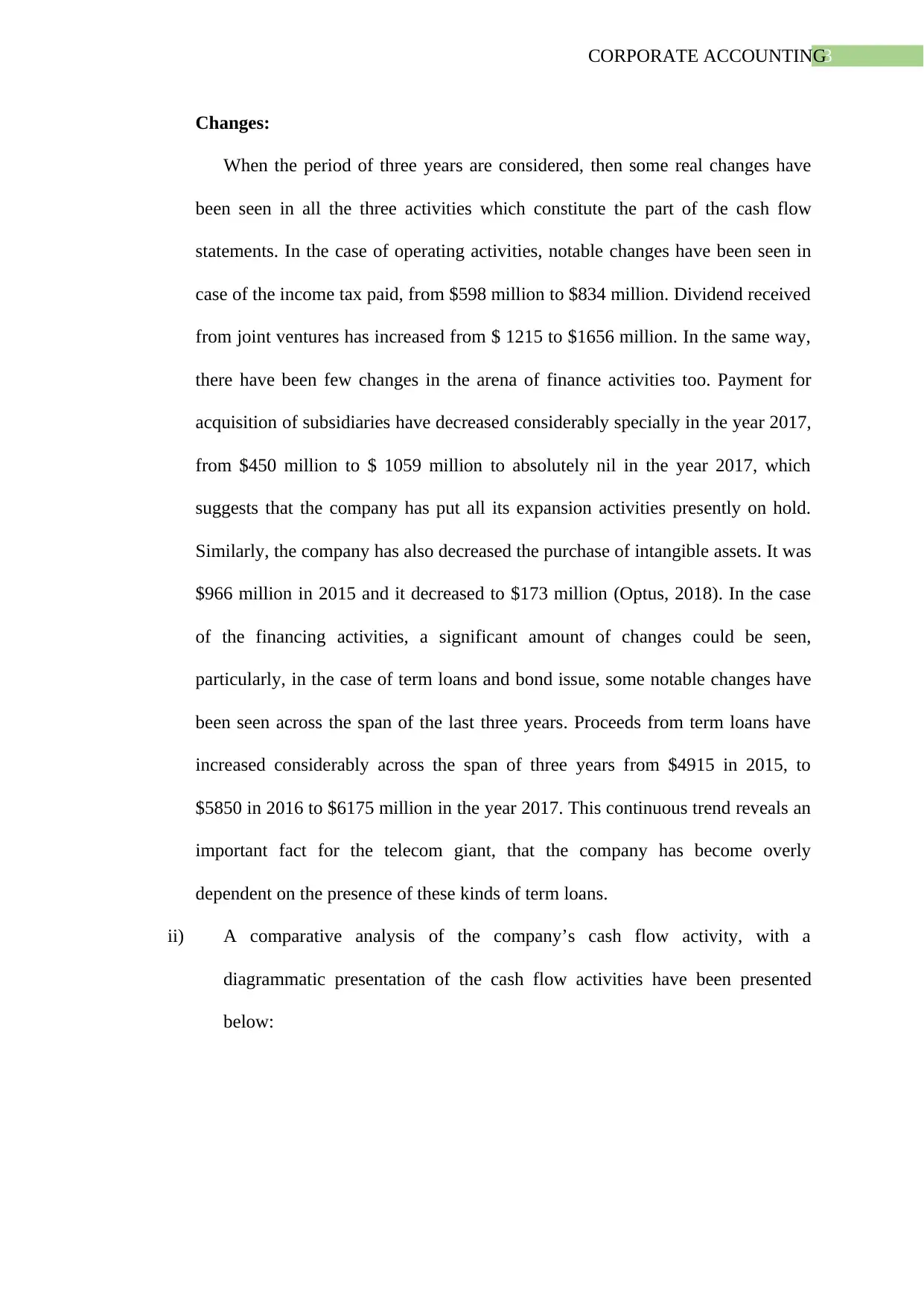
3CORPORATE ACCOUNTING
Changes:
When the period of three years are considered, then some real changes have
been seen in all the three activities which constitute the part of the cash flow
statements. In the case of operating activities, notable changes have been seen in
case of the income tax paid, from $598 million to $834 million. Dividend received
from joint ventures has increased from $ 1215 to $1656 million. In the same way,
there have been few changes in the arena of finance activities too. Payment for
acquisition of subsidiaries have decreased considerably specially in the year 2017,
from $450 million to $ 1059 million to absolutely nil in the year 2017, which
suggests that the company has put all its expansion activities presently on hold.
Similarly, the company has also decreased the purchase of intangible assets. It was
$966 million in 2015 and it decreased to $173 million (Optus, 2018). In the case
of the financing activities, a significant amount of changes could be seen,
particularly, in the case of term loans and bond issue, some notable changes have
been seen across the span of the last three years. Proceeds from term loans have
increased considerably across the span of three years from $4915 in 2015, to
$5850 in 2016 to $6175 million in the year 2017. This continuous trend reveals an
important fact for the telecom giant, that the company has become overly
dependent on the presence of these kinds of term loans.
ii) A comparative analysis of the company’s cash flow activity, with a
diagrammatic presentation of the cash flow activities have been presented
below:
Changes:
When the period of three years are considered, then some real changes have
been seen in all the three activities which constitute the part of the cash flow
statements. In the case of operating activities, notable changes have been seen in
case of the income tax paid, from $598 million to $834 million. Dividend received
from joint ventures has increased from $ 1215 to $1656 million. In the same way,
there have been few changes in the arena of finance activities too. Payment for
acquisition of subsidiaries have decreased considerably specially in the year 2017,
from $450 million to $ 1059 million to absolutely nil in the year 2017, which
suggests that the company has put all its expansion activities presently on hold.
Similarly, the company has also decreased the purchase of intangible assets. It was
$966 million in 2015 and it decreased to $173 million (Optus, 2018). In the case
of the financing activities, a significant amount of changes could be seen,
particularly, in the case of term loans and bond issue, some notable changes have
been seen across the span of the last three years. Proceeds from term loans have
increased considerably across the span of three years from $4915 in 2015, to
$5850 in 2016 to $6175 million in the year 2017. This continuous trend reveals an
important fact for the telecom giant, that the company has become overly
dependent on the presence of these kinds of term loans.
ii) A comparative analysis of the company’s cash flow activity, with a
diagrammatic presentation of the cash flow activities have been presented
below:
Paraphrase This Document
Need a fresh take? Get an instant paraphrase of this document with our AI Paraphraser
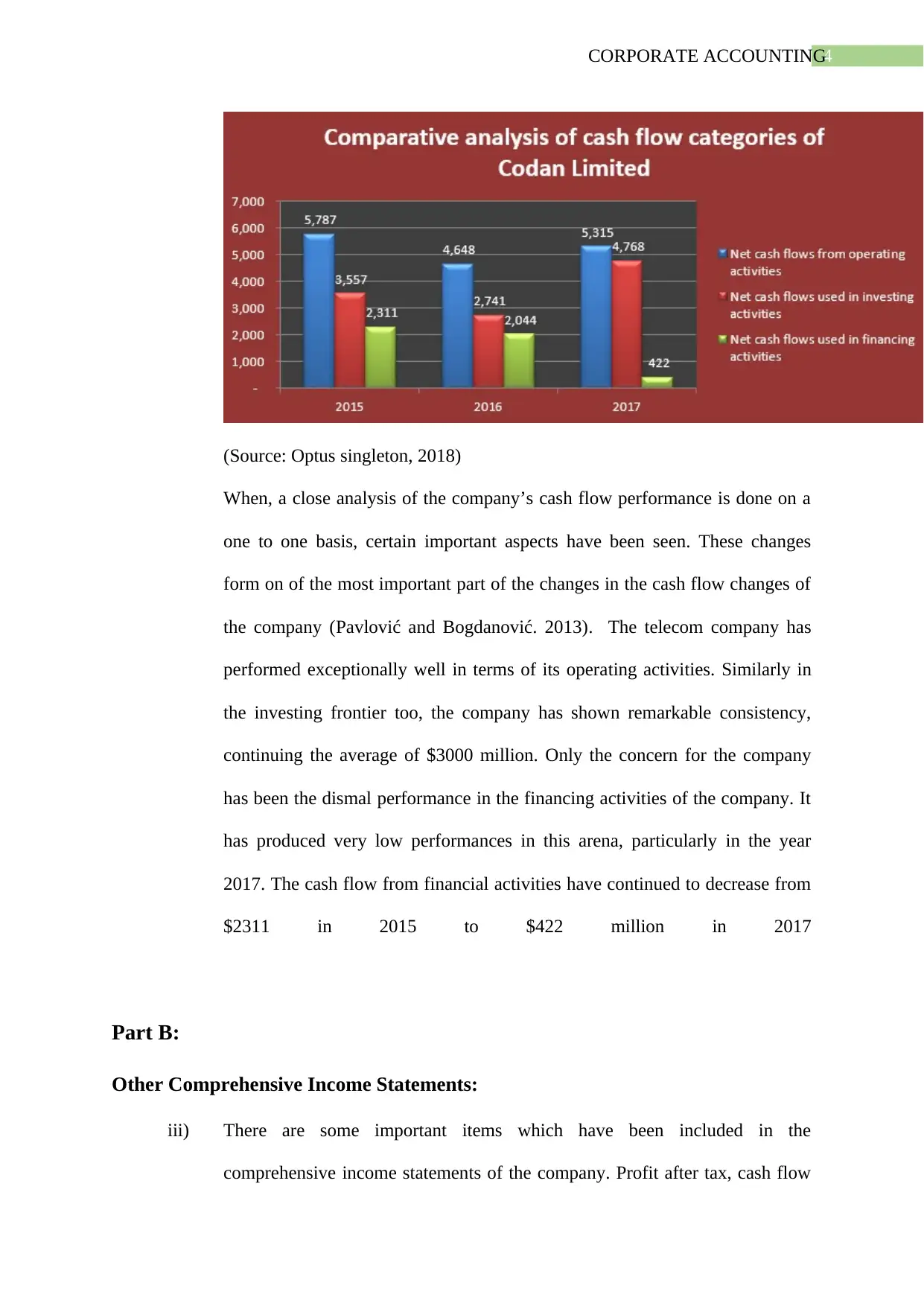
4CORPORATE ACCOUNTING
(Source: Optus singleton, 2018)
When, a close analysis of the company’s cash flow performance is done on a
one to one basis, certain important aspects have been seen. These changes
form on of the most important part of the changes in the cash flow changes of
the company (Pavlović and Bogdanović. 2013). The telecom company has
performed exceptionally well in terms of its operating activities. Similarly in
the investing frontier too, the company has shown remarkable consistency,
continuing the average of $3000 million. Only the concern for the company
has been the dismal performance in the financing activities of the company. It
has produced very low performances in this arena, particularly in the year
2017. The cash flow from financial activities have continued to decrease from
$2311 in 2015 to $422 million in 2017
Part B:
Other Comprehensive Income Statements:
iii) There are some important items which have been included in the
comprehensive income statements of the company. Profit after tax, cash flow
(Source: Optus singleton, 2018)
When, a close analysis of the company’s cash flow performance is done on a
one to one basis, certain important aspects have been seen. These changes
form on of the most important part of the changes in the cash flow changes of
the company (Pavlović and Bogdanović. 2013). The telecom company has
performed exceptionally well in terms of its operating activities. Similarly in
the investing frontier too, the company has shown remarkable consistency,
continuing the average of $3000 million. Only the concern for the company
has been the dismal performance in the financing activities of the company. It
has produced very low performances in this arena, particularly in the year
2017. The cash flow from financial activities have continued to decrease from
$2311 in 2015 to $422 million in 2017
Part B:
Other Comprehensive Income Statements:
iii) There are some important items which have been included in the
comprehensive income statements of the company. Profit after tax, cash flow
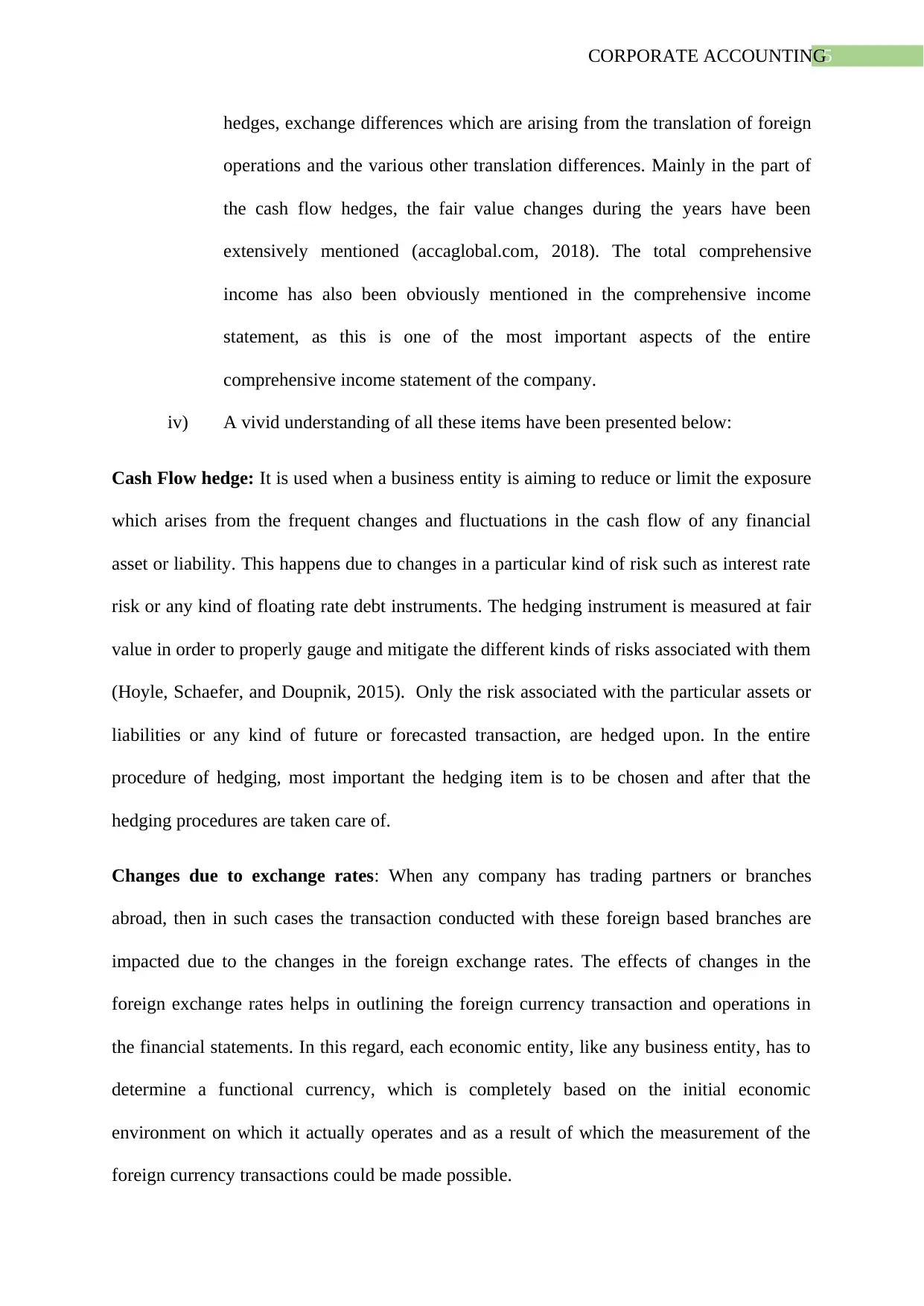
5CORPORATE ACCOUNTING
hedges, exchange differences which are arising from the translation of foreign
operations and the various other translation differences. Mainly in the part of
the cash flow hedges, the fair value changes during the years have been
extensively mentioned (accaglobal.com, 2018). The total comprehensive
income has also been obviously mentioned in the comprehensive income
statement, as this is one of the most important aspects of the entire
comprehensive income statement of the company.
iv) A vivid understanding of all these items have been presented below:
Cash Flow hedge: It is used when a business entity is aiming to reduce or limit the exposure
which arises from the frequent changes and fluctuations in the cash flow of any financial
asset or liability. This happens due to changes in a particular kind of risk such as interest rate
risk or any kind of floating rate debt instruments. The hedging instrument is measured at fair
value in order to properly gauge and mitigate the different kinds of risks associated with them
(Hoyle, Schaefer, and Doupnik, 2015). Only the risk associated with the particular assets or
liabilities or any kind of future or forecasted transaction, are hedged upon. In the entire
procedure of hedging, most important the hedging item is to be chosen and after that the
hedging procedures are taken care of.
Changes due to exchange rates: When any company has trading partners or branches
abroad, then in such cases the transaction conducted with these foreign based branches are
impacted due to the changes in the foreign exchange rates. The effects of changes in the
foreign exchange rates helps in outlining the foreign currency transaction and operations in
the financial statements. In this regard, each economic entity, like any business entity, has to
determine a functional currency, which is completely based on the initial economic
environment on which it actually operates and as a result of which the measurement of the
foreign currency transactions could be made possible.
hedges, exchange differences which are arising from the translation of foreign
operations and the various other translation differences. Mainly in the part of
the cash flow hedges, the fair value changes during the years have been
extensively mentioned (accaglobal.com, 2018). The total comprehensive
income has also been obviously mentioned in the comprehensive income
statement, as this is one of the most important aspects of the entire
comprehensive income statement of the company.
iv) A vivid understanding of all these items have been presented below:
Cash Flow hedge: It is used when a business entity is aiming to reduce or limit the exposure
which arises from the frequent changes and fluctuations in the cash flow of any financial
asset or liability. This happens due to changes in a particular kind of risk such as interest rate
risk or any kind of floating rate debt instruments. The hedging instrument is measured at fair
value in order to properly gauge and mitigate the different kinds of risks associated with them
(Hoyle, Schaefer, and Doupnik, 2015). Only the risk associated with the particular assets or
liabilities or any kind of future or forecasted transaction, are hedged upon. In the entire
procedure of hedging, most important the hedging item is to be chosen and after that the
hedging procedures are taken care of.
Changes due to exchange rates: When any company has trading partners or branches
abroad, then in such cases the transaction conducted with these foreign based branches are
impacted due to the changes in the foreign exchange rates. The effects of changes in the
foreign exchange rates helps in outlining the foreign currency transaction and operations in
the financial statements. In this regard, each economic entity, like any business entity, has to
determine a functional currency, which is completely based on the initial economic
environment on which it actually operates and as a result of which the measurement of the
foreign currency transactions could be made possible.
⊘ This is a preview!⊘
Do you want full access?
Subscribe today to unlock all pages.

Trusted by 1+ million students worldwide
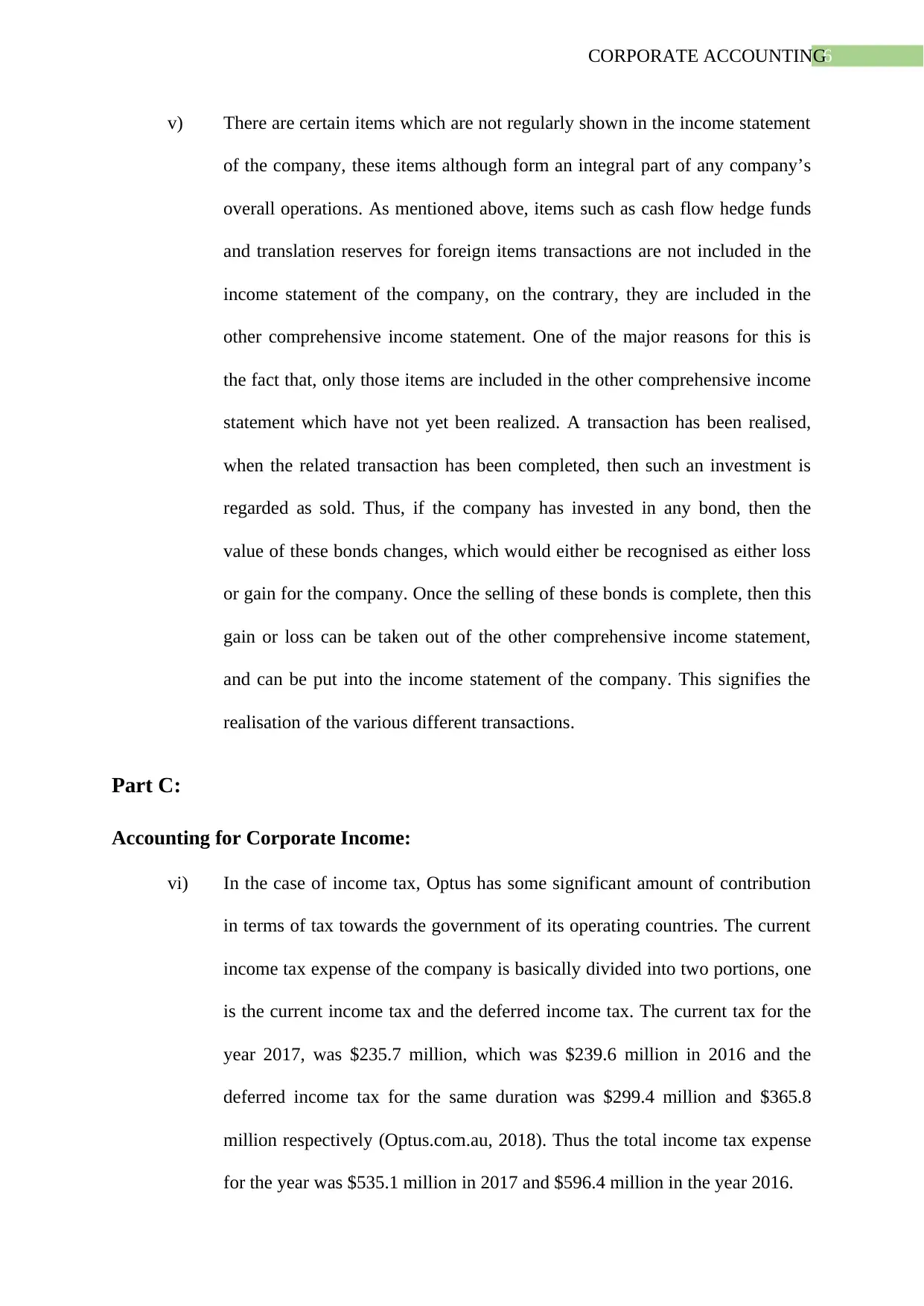
6CORPORATE ACCOUNTING
v) There are certain items which are not regularly shown in the income statement
of the company, these items although form an integral part of any company’s
overall operations. As mentioned above, items such as cash flow hedge funds
and translation reserves for foreign items transactions are not included in the
income statement of the company, on the contrary, they are included in the
other comprehensive income statement. One of the major reasons for this is
the fact that, only those items are included in the other comprehensive income
statement which have not yet been realized. A transaction has been realised,
when the related transaction has been completed, then such an investment is
regarded as sold. Thus, if the company has invested in any bond, then the
value of these bonds changes, which would either be recognised as either loss
or gain for the company. Once the selling of these bonds is complete, then this
gain or loss can be taken out of the other comprehensive income statement,
and can be put into the income statement of the company. This signifies the
realisation of the various different transactions.
Part C:
Accounting for Corporate Income:
vi) In the case of income tax, Optus has some significant amount of contribution
in terms of tax towards the government of its operating countries. The current
income tax expense of the company is basically divided into two portions, one
is the current income tax and the deferred income tax. The current tax for the
year 2017, was $235.7 million, which was $239.6 million in 2016 and the
deferred income tax for the same duration was $299.4 million and $365.8
million respectively (Optus.com.au, 2018). Thus the total income tax expense
for the year was $535.1 million in 2017 and $596.4 million in the year 2016.
v) There are certain items which are not regularly shown in the income statement
of the company, these items although form an integral part of any company’s
overall operations. As mentioned above, items such as cash flow hedge funds
and translation reserves for foreign items transactions are not included in the
income statement of the company, on the contrary, they are included in the
other comprehensive income statement. One of the major reasons for this is
the fact that, only those items are included in the other comprehensive income
statement which have not yet been realized. A transaction has been realised,
when the related transaction has been completed, then such an investment is
regarded as sold. Thus, if the company has invested in any bond, then the
value of these bonds changes, which would either be recognised as either loss
or gain for the company. Once the selling of these bonds is complete, then this
gain or loss can be taken out of the other comprehensive income statement,
and can be put into the income statement of the company. This signifies the
realisation of the various different transactions.
Part C:
Accounting for Corporate Income:
vi) In the case of income tax, Optus has some significant amount of contribution
in terms of tax towards the government of its operating countries. The current
income tax expense of the company is basically divided into two portions, one
is the current income tax and the deferred income tax. The current tax for the
year 2017, was $235.7 million, which was $239.6 million in 2016 and the
deferred income tax for the same duration was $299.4 million and $365.8
million respectively (Optus.com.au, 2018). Thus the total income tax expense
for the year was $535.1 million in 2017 and $596.4 million in the year 2016.
Paraphrase This Document
Need a fresh take? Get an instant paraphrase of this document with our AI Paraphraser
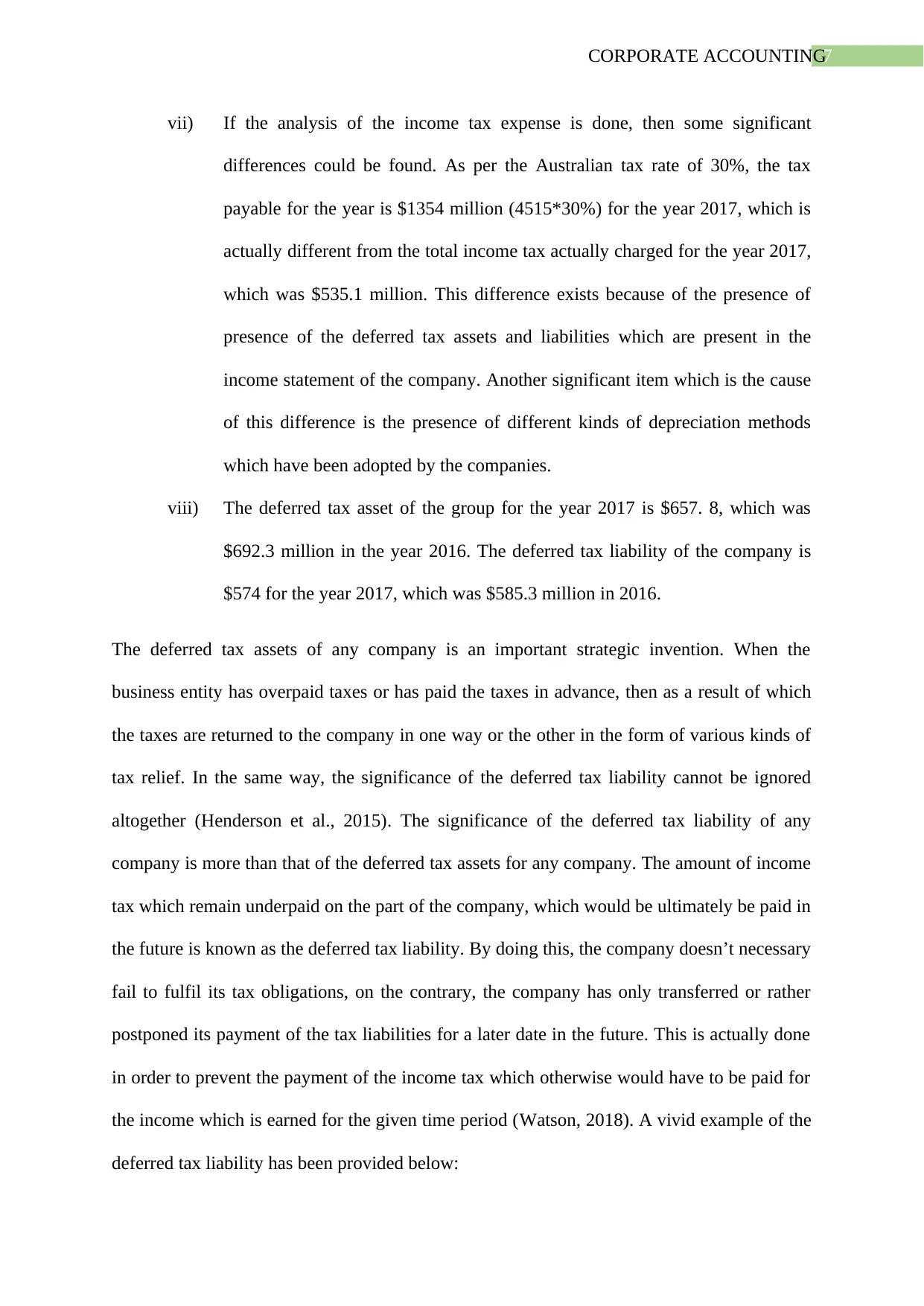
7CORPORATE ACCOUNTING
vii) If the analysis of the income tax expense is done, then some significant
differences could be found. As per the Australian tax rate of 30%, the tax
payable for the year is $1354 million (4515*30%) for the year 2017, which is
actually different from the total income tax actually charged for the year 2017,
which was $535.1 million. This difference exists because of the presence of
presence of the deferred tax assets and liabilities which are present in the
income statement of the company. Another significant item which is the cause
of this difference is the presence of different kinds of depreciation methods
which have been adopted by the companies.
viii) The deferred tax asset of the group for the year 2017 is $657. 8, which was
$692.3 million in the year 2016. The deferred tax liability of the company is
$574 for the year 2017, which was $585.3 million in 2016.
The deferred tax assets of any company is an important strategic invention. When the
business entity has overpaid taxes or has paid the taxes in advance, then as a result of which
the taxes are returned to the company in one way or the other in the form of various kinds of
tax relief. In the same way, the significance of the deferred tax liability cannot be ignored
altogether (Henderson et al., 2015). The significance of the deferred tax liability of any
company is more than that of the deferred tax assets for any company. The amount of income
tax which remain underpaid on the part of the company, which would be ultimately be paid in
the future is known as the deferred tax liability. By doing this, the company doesn’t necessary
fail to fulfil its tax obligations, on the contrary, the company has only transferred or rather
postponed its payment of the tax liabilities for a later date in the future. This is actually done
in order to prevent the payment of the income tax which otherwise would have to be paid for
the income which is earned for the given time period (Watson, 2018). A vivid example of the
deferred tax liability has been provided below:
vii) If the analysis of the income tax expense is done, then some significant
differences could be found. As per the Australian tax rate of 30%, the tax
payable for the year is $1354 million (4515*30%) for the year 2017, which is
actually different from the total income tax actually charged for the year 2017,
which was $535.1 million. This difference exists because of the presence of
presence of the deferred tax assets and liabilities which are present in the
income statement of the company. Another significant item which is the cause
of this difference is the presence of different kinds of depreciation methods
which have been adopted by the companies.
viii) The deferred tax asset of the group for the year 2017 is $657. 8, which was
$692.3 million in the year 2016. The deferred tax liability of the company is
$574 for the year 2017, which was $585.3 million in 2016.
The deferred tax assets of any company is an important strategic invention. When the
business entity has overpaid taxes or has paid the taxes in advance, then as a result of which
the taxes are returned to the company in one way or the other in the form of various kinds of
tax relief. In the same way, the significance of the deferred tax liability cannot be ignored
altogether (Henderson et al., 2015). The significance of the deferred tax liability of any
company is more than that of the deferred tax assets for any company. The amount of income
tax which remain underpaid on the part of the company, which would be ultimately be paid in
the future is known as the deferred tax liability. By doing this, the company doesn’t necessary
fail to fulfil its tax obligations, on the contrary, the company has only transferred or rather
postponed its payment of the tax liabilities for a later date in the future. This is actually done
in order to prevent the payment of the income tax which otherwise would have to be paid for
the income which is earned for the given time period (Watson, 2018). A vivid example of the
deferred tax liability has been provided below:
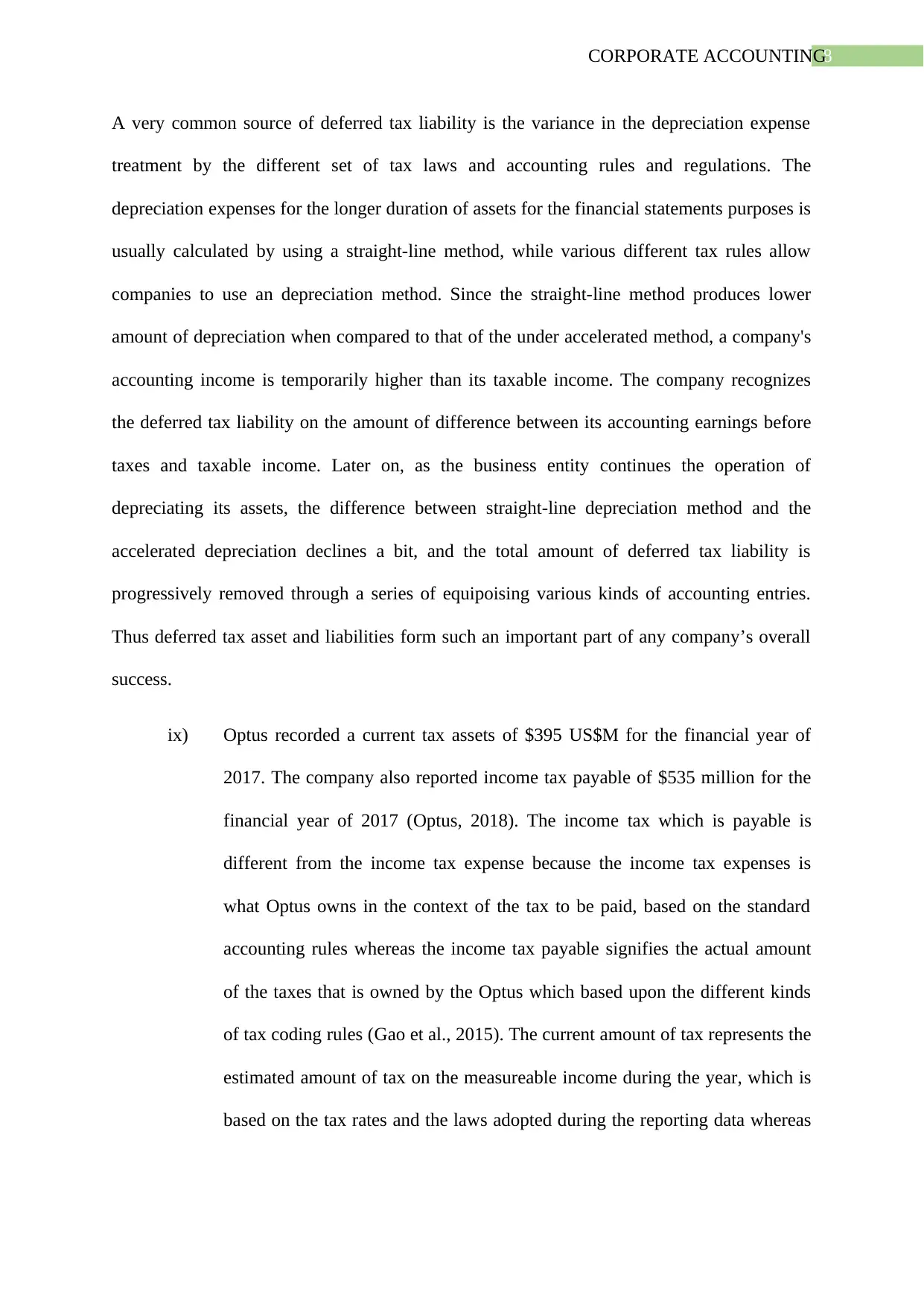
8CORPORATE ACCOUNTING
A very common source of deferred tax liability is the variance in the depreciation expense
treatment by the different set of tax laws and accounting rules and regulations. The
depreciation expenses for the longer duration of assets for the financial statements purposes is
usually calculated by using a straight-line method, while various different tax rules allow
companies to use an depreciation method. Since the straight-line method produces lower
amount of depreciation when compared to that of the under accelerated method, a company's
accounting income is temporarily higher than its taxable income. The company recognizes
the deferred tax liability on the amount of difference between its accounting earnings before
taxes and taxable income. Later on, as the business entity continues the operation of
depreciating its assets, the difference between straight-line depreciation method and the
accelerated depreciation declines a bit, and the total amount of deferred tax liability is
progressively removed through a series of equipoising various kinds of accounting entries.
Thus deferred tax asset and liabilities form such an important part of any company’s overall
success.
ix) Optus recorded a current tax assets of $395 US$M for the financial year of
2017. The company also reported income tax payable of $535 million for the
financial year of 2017 (Optus, 2018). The income tax which is payable is
different from the income tax expense because the income tax expenses is
what Optus owns in the context of the tax to be paid, based on the standard
accounting rules whereas the income tax payable signifies the actual amount
of the taxes that is owned by the Optus which based upon the different kinds
of tax coding rules (Gao et al., 2015). The current amount of tax represents the
estimated amount of tax on the measureable income during the year, which is
based on the tax rates and the laws adopted during the reporting data whereas
A very common source of deferred tax liability is the variance in the depreciation expense
treatment by the different set of tax laws and accounting rules and regulations. The
depreciation expenses for the longer duration of assets for the financial statements purposes is
usually calculated by using a straight-line method, while various different tax rules allow
companies to use an depreciation method. Since the straight-line method produces lower
amount of depreciation when compared to that of the under accelerated method, a company's
accounting income is temporarily higher than its taxable income. The company recognizes
the deferred tax liability on the amount of difference between its accounting earnings before
taxes and taxable income. Later on, as the business entity continues the operation of
depreciating its assets, the difference between straight-line depreciation method and the
accelerated depreciation declines a bit, and the total amount of deferred tax liability is
progressively removed through a series of equipoising various kinds of accounting entries.
Thus deferred tax asset and liabilities form such an important part of any company’s overall
success.
ix) Optus recorded a current tax assets of $395 US$M for the financial year of
2017. The company also reported income tax payable of $535 million for the
financial year of 2017 (Optus, 2018). The income tax which is payable is
different from the income tax expense because the income tax expenses is
what Optus owns in the context of the tax to be paid, based on the standard
accounting rules whereas the income tax payable signifies the actual amount
of the taxes that is owned by the Optus which based upon the different kinds
of tax coding rules (Gao et al., 2015). The current amount of tax represents the
estimated amount of tax on the measureable income during the year, which is
based on the tax rates and the laws adopted during the reporting data whereas
⊘ This is a preview!⊘
Do you want full access?
Subscribe today to unlock all pages.

Trusted by 1+ million students worldwide
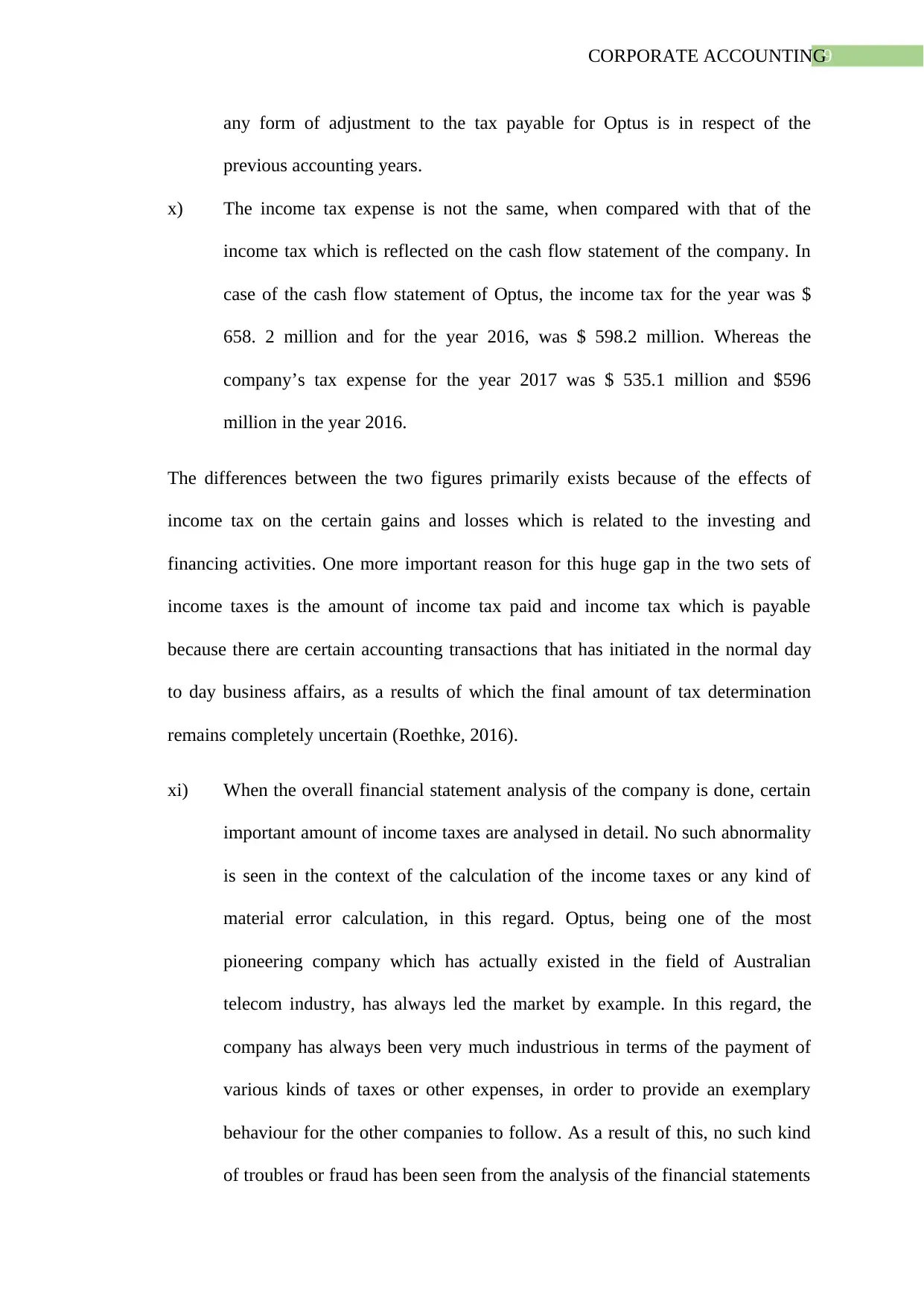
9CORPORATE ACCOUNTING
any form of adjustment to the tax payable for Optus is in respect of the
previous accounting years.
x) The income tax expense is not the same, when compared with that of the
income tax which is reflected on the cash flow statement of the company. In
case of the cash flow statement of Optus, the income tax for the year was $
658. 2 million and for the year 2016, was $ 598.2 million. Whereas the
company’s tax expense for the year 2017 was $ 535.1 million and $596
million in the year 2016.
The differences between the two figures primarily exists because of the effects of
income tax on the certain gains and losses which is related to the investing and
financing activities. One more important reason for this huge gap in the two sets of
income taxes is the amount of income tax paid and income tax which is payable
because there are certain accounting transactions that has initiated in the normal day
to day business affairs, as a results of which the final amount of tax determination
remains completely uncertain (Roethke, 2016).
xi) When the overall financial statement analysis of the company is done, certain
important amount of income taxes are analysed in detail. No such abnormality
is seen in the context of the calculation of the income taxes or any kind of
material error calculation, in this regard. Optus, being one of the most
pioneering company which has actually existed in the field of Australian
telecom industry, has always led the market by example. In this regard, the
company has always been very much industrious in terms of the payment of
various kinds of taxes or other expenses, in order to provide an exemplary
behaviour for the other companies to follow. As a result of this, no such kind
of troubles or fraud has been seen from the analysis of the financial statements
any form of adjustment to the tax payable for Optus is in respect of the
previous accounting years.
x) The income tax expense is not the same, when compared with that of the
income tax which is reflected on the cash flow statement of the company. In
case of the cash flow statement of Optus, the income tax for the year was $
658. 2 million and for the year 2016, was $ 598.2 million. Whereas the
company’s tax expense for the year 2017 was $ 535.1 million and $596
million in the year 2016.
The differences between the two figures primarily exists because of the effects of
income tax on the certain gains and losses which is related to the investing and
financing activities. One more important reason for this huge gap in the two sets of
income taxes is the amount of income tax paid and income tax which is payable
because there are certain accounting transactions that has initiated in the normal day
to day business affairs, as a results of which the final amount of tax determination
remains completely uncertain (Roethke, 2016).
xi) When the overall financial statement analysis of the company is done, certain
important amount of income taxes are analysed in detail. No such abnormality
is seen in the context of the calculation of the income taxes or any kind of
material error calculation, in this regard. Optus, being one of the most
pioneering company which has actually existed in the field of Australian
telecom industry, has always led the market by example. In this regard, the
company has always been very much industrious in terms of the payment of
various kinds of taxes or other expenses, in order to provide an exemplary
behaviour for the other companies to follow. As a result of this, no such kind
of troubles or fraud has been seen from the analysis of the financial statements
Paraphrase This Document
Need a fresh take? Get an instant paraphrase of this document with our AI Paraphraser
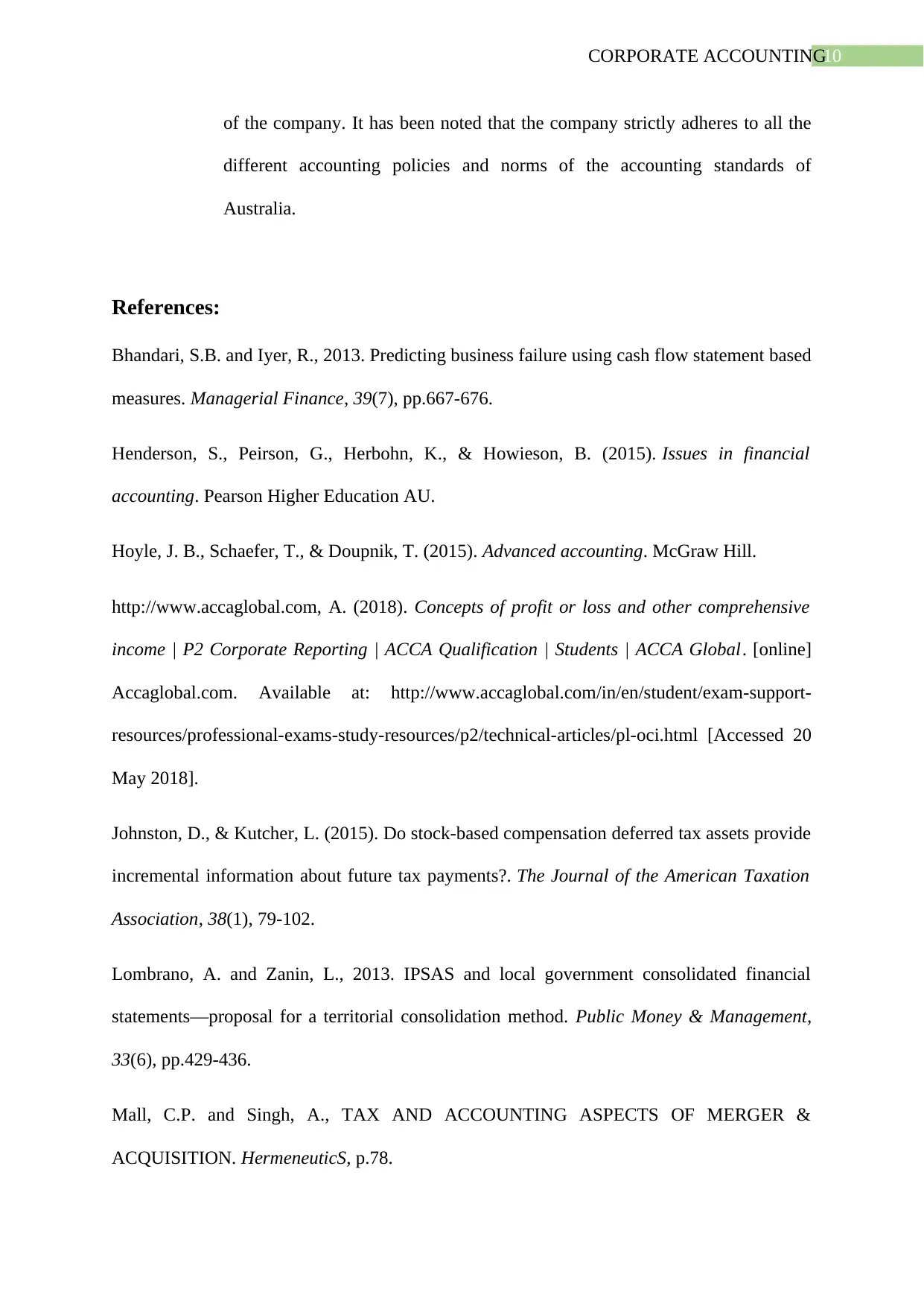
10CORPORATE ACCOUNTING
of the company. It has been noted that the company strictly adheres to all the
different accounting policies and norms of the accounting standards of
Australia.
References:
Bhandari, S.B. and Iyer, R., 2013. Predicting business failure using cash flow statement based
measures. Managerial Finance, 39(7), pp.667-676.
Henderson, S., Peirson, G., Herbohn, K., & Howieson, B. (2015). Issues in financial
accounting. Pearson Higher Education AU.
Hoyle, J. B., Schaefer, T., & Doupnik, T. (2015). Advanced accounting. McGraw Hill.
http://www.accaglobal.com, A. (2018). Concepts of profit or loss and other comprehensive
income | P2 Corporate Reporting | ACCA Qualification | Students | ACCA Global. [online]
Accaglobal.com. Available at: http://www.accaglobal.com/in/en/student/exam-support-
resources/professional-exams-study-resources/p2/technical-articles/pl-oci.html [Accessed 20
May 2018].
Johnston, D., & Kutcher, L. (2015). Do stock-based compensation deferred tax assets provide
incremental information about future tax payments?. The Journal of the American Taxation
Association, 38(1), 79-102.
Lombrano, A. and Zanin, L., 2013. IPSAS and local government consolidated financial
statements—proposal for a territorial consolidation method. Public Money & Management,
33(6), pp.429-436.
Mall, C.P. and Singh, A., TAX AND ACCOUNTING ASPECTS OF MERGER &
ACQUISITION. HermeneuticS, p.78.
of the company. It has been noted that the company strictly adheres to all the
different accounting policies and norms of the accounting standards of
Australia.
References:
Bhandari, S.B. and Iyer, R., 2013. Predicting business failure using cash flow statement based
measures. Managerial Finance, 39(7), pp.667-676.
Henderson, S., Peirson, G., Herbohn, K., & Howieson, B. (2015). Issues in financial
accounting. Pearson Higher Education AU.
Hoyle, J. B., Schaefer, T., & Doupnik, T. (2015). Advanced accounting. McGraw Hill.
http://www.accaglobal.com, A. (2018). Concepts of profit or loss and other comprehensive
income | P2 Corporate Reporting | ACCA Qualification | Students | ACCA Global. [online]
Accaglobal.com. Available at: http://www.accaglobal.com/in/en/student/exam-support-
resources/professional-exams-study-resources/p2/technical-articles/pl-oci.html [Accessed 20
May 2018].
Johnston, D., & Kutcher, L. (2015). Do stock-based compensation deferred tax assets provide
incremental information about future tax payments?. The Journal of the American Taxation
Association, 38(1), 79-102.
Lombrano, A. and Zanin, L., 2013. IPSAS and local government consolidated financial
statements—proposal for a territorial consolidation method. Public Money & Management,
33(6), pp.429-436.
Mall, C.P. and Singh, A., TAX AND ACCOUNTING ASPECTS OF MERGER &
ACQUISITION. HermeneuticS, p.78.
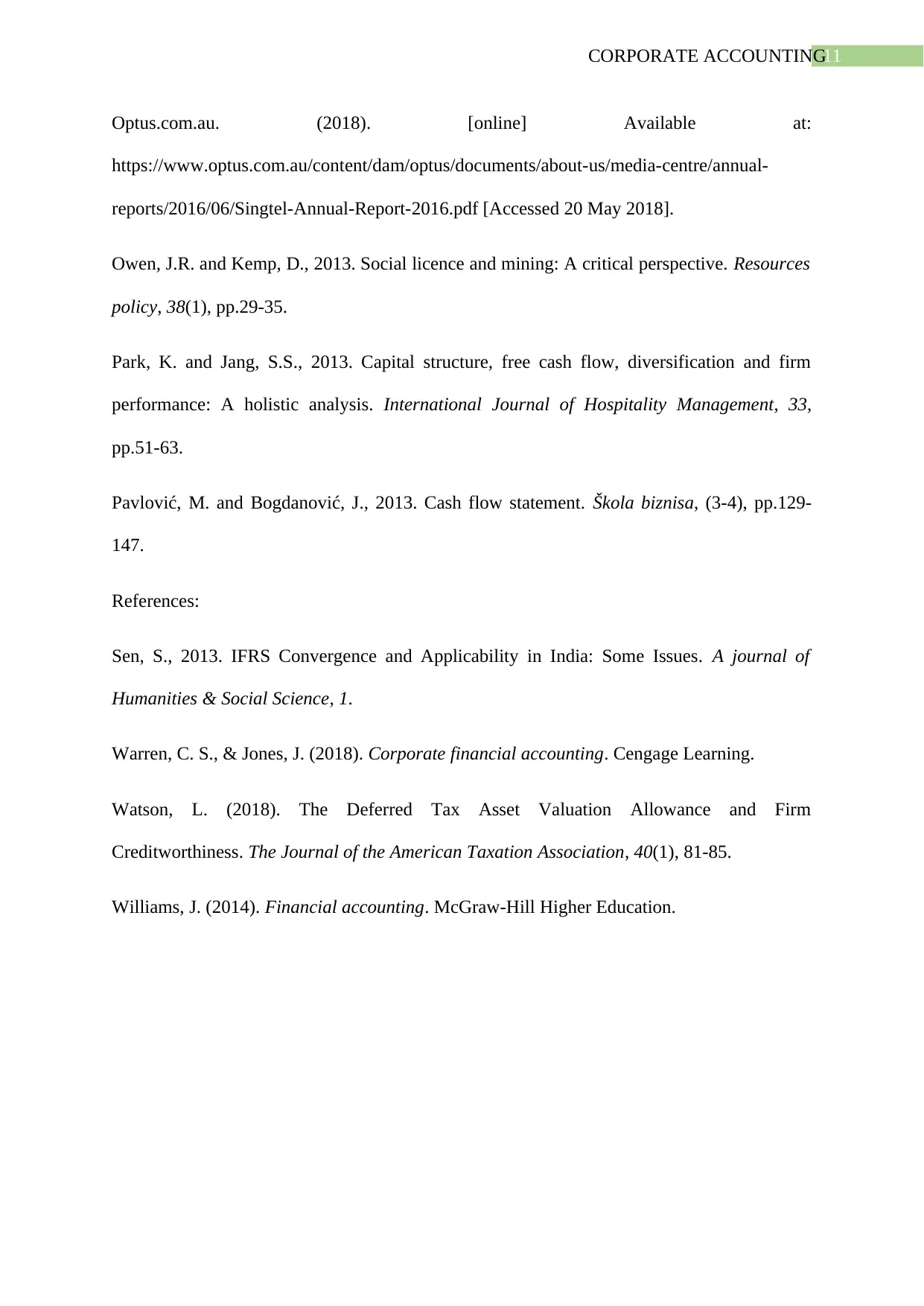
11CORPORATE ACCOUNTING
Optus.com.au. (2018). [online] Available at:
https://www.optus.com.au/content/dam/optus/documents/about-us/media-centre/annual-
reports/2016/06/Singtel-Annual-Report-2016.pdf [Accessed 20 May 2018].
Owen, J.R. and Kemp, D., 2013. Social licence and mining: A critical perspective. Resources
policy, 38(1), pp.29-35.
Park, K. and Jang, S.S., 2013. Capital structure, free cash flow, diversification and firm
performance: A holistic analysis. International Journal of Hospitality Management, 33,
pp.51-63.
Pavlović, M. and Bogdanović, J., 2013. Cash flow statement. Škola biznisa, (3-4), pp.129-
147.
References:
Sen, S., 2013. IFRS Convergence and Applicability in India: Some Issues. A journal of
Humanities & Social Science, 1.
Warren, C. S., & Jones, J. (2018). Corporate financial accounting. Cengage Learning.
Watson, L. (2018). The Deferred Tax Asset Valuation Allowance and Firm
Creditworthiness. The Journal of the American Taxation Association, 40(1), 81-85.
Williams, J. (2014). Financial accounting. McGraw-Hill Higher Education.
Optus.com.au. (2018). [online] Available at:
https://www.optus.com.au/content/dam/optus/documents/about-us/media-centre/annual-
reports/2016/06/Singtel-Annual-Report-2016.pdf [Accessed 20 May 2018].
Owen, J.R. and Kemp, D., 2013. Social licence and mining: A critical perspective. Resources
policy, 38(1), pp.29-35.
Park, K. and Jang, S.S., 2013. Capital structure, free cash flow, diversification and firm
performance: A holistic analysis. International Journal of Hospitality Management, 33,
pp.51-63.
Pavlović, M. and Bogdanović, J., 2013. Cash flow statement. Škola biznisa, (3-4), pp.129-
147.
References:
Sen, S., 2013. IFRS Convergence and Applicability in India: Some Issues. A journal of
Humanities & Social Science, 1.
Warren, C. S., & Jones, J. (2018). Corporate financial accounting. Cengage Learning.
Watson, L. (2018). The Deferred Tax Asset Valuation Allowance and Firm
Creditworthiness. The Journal of the American Taxation Association, 40(1), 81-85.
Williams, J. (2014). Financial accounting. McGraw-Hill Higher Education.
⊘ This is a preview!⊘
Do you want full access?
Subscribe today to unlock all pages.

Trusted by 1+ million students worldwide
1 out of 13
Related Documents
Your All-in-One AI-Powered Toolkit for Academic Success.
+13062052269
info@desklib.com
Available 24*7 on WhatsApp / Email
![[object Object]](/_next/static/media/star-bottom.7253800d.svg)
Unlock your academic potential
Copyright © 2020–2025 A2Z Services. All Rights Reserved. Developed and managed by ZUCOL.





